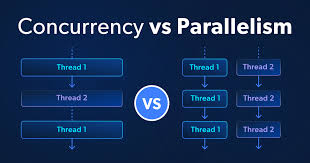 Here’s a detailed comparison table for various concurrency models, including examples, strengths, weaknesses, scalability,
resource usage, complexity, production readiness, and suitable architectures:
Here’s a detailed comparison table for various concurrency models, including examples, strengths, weaknesses, scalability,
resource usage, complexity, production readiness, and suitable architectures:
| ✅ | Model | Examples | Strengths | Weaknesses | Best For | Scalability | Resource Usage | Complexity | Production Ready | Suitable Architectures |
|---|---|---|---|---|---|---|---|---|---|---|
| [ ] | Pre-Fork | Gunicorn, Apache HTTP (prefork mode) | - Reliable and predictable. - Handles CPU-intensive workloads well. | - High memory usage (one process per worker). - Limited scalability for high concurrency. | CPU-intensive workloads. Monolithic apps. | Moderate | High | Low | Yes | Monolithic, legacy systems. |
| [x] | Thread-Based | Apache Tomcat, Jetty, Python threading | - Lower memory usage than pre-fork. - Good for I/O-bound workloads. | - Risk of race conditions. - Performance degrades with too many threads. | I/O-bound workloads. Web servers. | High | Moderate | Moderate | Yes | Monolithic, microservices. |
| [x] | Event-Driven | Nginx, Uvicorn, Node.js | - Extremely efficient for I/O-bound tasks. - Low resource usage. - High concurrency. | - Not suited for CPU-heavy tasks. - Higher complexity due to async programming. | APIs, WebSockets, real-time apps. | Very High | Low | High | Yes | Serverless, microservices. |
| [ ] | Hybrid (Pre-Fork + Threads/Async) | Gunicorn with threads, Apache HTTP (worker/event MPM), Puma | - Combines benefits of processes and threads/async. - Scalable for mixed workloads. | - More complex to configure and manage. - Needs tuning of worker/thread counts. | Mixed workloads, multi-core CPUs. | High | Moderate | High | Yes | Monolithic, microservices. |
| [x] | Single-Process, Single-Thread | Python http.server, older CGI | - Simple and easy to implement. - Minimal resource usage. | - Cannot handle concurrent requests. - Not scalable for production use. | Low-traffic apps, development. | Low | Low | Very Low | No | Monolithic (small apps). |
| [ ] | Multiplexing (Worker Pool) | Apache HTTP (worker MPM), ThreadPoolExecutor | - Efficient resource utilization. - Scalable for moderate traffic. | - Latency if all workers are busy. - Requires careful tuning of pool size. | Moderate concurrency workloads. | High | Moderate | Moderate | Yes | Monolithic, microservices. |
| [ ] | Reactive | Akka (Scala), Vert.x (Java), Spring WebFlux | - Highly efficient for real-time, event-driven apps. - Minimal resource usage. | - Requires reactive programming. - Steep learning curve. | Real-time apps, event-driven systems. | Very High | Low | High | Yes | Event-driven, microservices. |
| [ ] | Container-Based | Kubernetes, AWS Fargate, Google Cloud Run | - Dynamically scalable. - Isolated and resilient. - Ideal for microservices. | - Higher startup latency. - Overhead from container orchestration. | Microservices, modern architectures. | Very High | Moderate-High | High | Yes | Microservices, serverless. |
Key Takeaways:
- Pre-Fork: Best for monolithic, CPU-heavy apps where stability is key. Suitable for legacy systems.
- Thread-Based: Works well for I/O-heavy workloads, but can struggle with race conditions in high concurrency.
- Event-Driven: Ideal for lightweight, high-concurrency use cases like APIs and WebSockets. Common for serverless and microservices.
- Hybrid: Balances the strengths of pre-fork and threading/async models. Good for mixed workloads.
- Single-Process: Simple for development but not scalable for production.
- Multiplexing: Great for moderate concurrency workloads with efficient resource usage, but requires careful tuning.
- Reactive: Perfect for real-time, event-driven systems but requires expertise in reactive programming.
- Container-Based: The go-to for modern architectures like microservices and serverless, with excellent scalability and isolation.